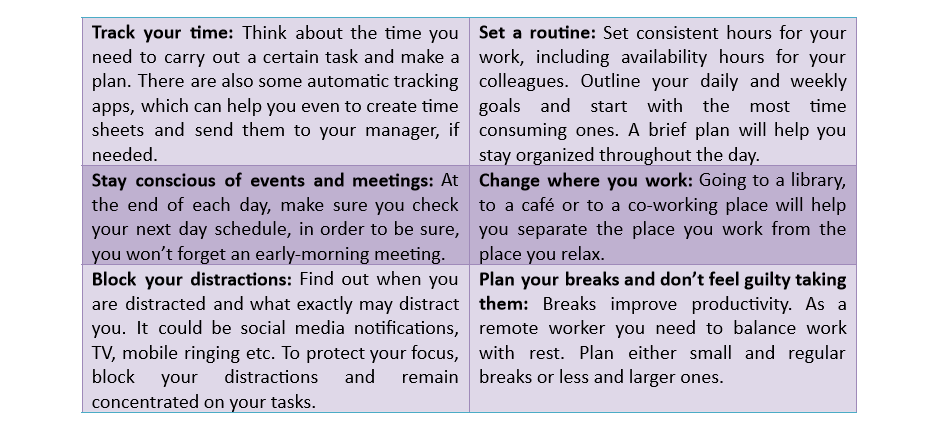Remote working

How to manage work from home
Staying at home orders prompted by COVID-19, created a challenge for all employees. Some companies implemented remote working policies for the first time (Gurchiek, 2020). This unprecedented situation brought major changes to the labor market. The majority of the employees had to deal with telework; however, many of them might experience work from home for the first time. Therefore, some tips for managing effectively remote working are listed below (Remote Year, 2019):
- Over – communicate: When you are working from home, communication among colleagues is less direct than being in a real working environment. Hence you have to over – communicate with your co-workers and chief, in order to inform them about your progress or about some obstacles you are probably facing.
- Invest in reliable tech: High quality equipment is of vital importance, when working from home. For example, you need to participate in video calls without losing internet connection or you may need some noise – cancelling headphones, so that you can reduce auditory distractions.
- Lean on your community: Remote working may trigger a feeling of loneliness, because you are not surrounded by your team. In such case you can attend a remote community either virtually or in-person at a local co-working space.
- Consider your workspace: Organize your workspace, so that you can stay focused throughout the day and motivated to carry out your tasks. This place doesn’t necessarily need to be at home. It could also be on the outside.
- Figure out your working style: If you are experiencing remote working for the first time, spend some time thinking about the best environment you would prefer to work in. For instance, you might enjoy working in a place with some music in the background or you might need total silence. You can also decide the most suitable time for you to work, either in the morning or the evening.
- Take time for self-care: Remember to spend some time doing your favorite activities and avoid being absorbed in the computer too many hours, if not necessary.
- Know when to “log off”: One of the benefits of working from home is that you can be flexible concerning your program. However, you might receive emails or notifications any time. Define a certain period of time, when you will officially “log off” and take a break.
- Embrace remote working advantages: Enjoy flexibility and new working environment designed according to your needs.
How to get psychologically ready
The pandemic forced many people to work remotely. In the beginning it seemed temporary; however, remote working now has become a long-term situation. Some people have managed to cope with telework. On the other hand, it feels like a nightmare to others (6 Ways You Can Mentally and Emotionally Prepare for Working from Home Long Term, 2020). There are some tips you can follow, in order to be mentally and emotionally prepared for remote working (How to Work From Home and Stay Emotionally Healthy, 2020):

Time management and productivity
Working from home may turn out to be difficult regarding time management and thus productivity. When we are home and not in a real working environment, it is likely to feel disorganized and overwhelmed by the workload. Some strategies aiming at enhancing time management and productivity are listed below (Time Management Strategies for Remote Workers – Timely Blog, 2020):

Configure your workspace
One of the first recommendations when it comes to remote working is “setting up a work-from-home space that’s as functional and comfortable (and calming!) as possible” (Holdefehr, 2020). Below there are some guidelines for picking up a productive workspace (Holdefehr, 2020):
- Pick the right spot: Choose a spot, where you think you will be more productive. Ideally the spot should be away from possible distractions and also receive natural light. If you have kids who need supervision, you may think of picking a spot near to them.
- Set up proper lightning: To avoid eyestrain, try to provide your workspace with sufficient lightning. You may choose a place nearby a window. In any case you should have a lamp to supply you with the light needed, when it gets dark.
- Make it as ergonomic as possible: It might be difficult to buy new equipment. Therefore, try to combine your own furniture in order to create a convenient and ergonomic workplace. Prefer a chair with back support and an office or a table with enough space for your equipment.
- Get connected: Ideally your workplace should be located near a power outlet. Check also the internet connection and consider an upgrade in case of poor connection.
- Avoid working from bed or couch: Try to separate the workspace from your relaxation zone, in order to create some mental distance.
- Decorate: Use your own taste and design the workplace respectively.
Childcare and housework
Many working parents are facing an unprecedented situation: working from home with kids and without help from grandparents, babysitters etc. There are definitely some difficulties in handling both childcare and remote working, but there are some strategies aiming at assisting you to cope with this situation (Douglas, 2020):
- Get a creative schedule: If there is another adult in the house you can consider a split schedule. Find hours that kids are occupied with another activity or they are asleep. Throughout the day try to take into consideration deadlines and organize your tasks.
- Communicate with your boss often: Explain your boss that because of the fact that you are a parent and you should also take care of your children, you will try your best to reach the desirable outcome and that you have also prepared a plan of your availability hours. Emphasize that you will regularly keep in touch with him/her to inform him/her about the progress and possible barriers.
- Stick to a routine: Create a schedule and after discussing it with your family members, try to follow it. Avoid changing your routine because it will cause disorganization to all members and especially to you.
- Use visual cues to avoid interruptions: For instance, use some stop signs indicating to your children that they have to be quiet for some time. If there is another adult in the house and you need to participate in a video call, ask him/her to take care of the children for a while.
- Let kids make some choices: Let them choose their own activities, unless they do not bother your work significantly. If they are a little bit older, let them prepare their meals. For example, you can make a list of lunch choices and snack choices, so that they can choose any time they like.
- Plan breaks with the kids: Breaks are essential when working. You need to take breaks in order to relax or spend time with your children. Choose the most appropriate time to do so.

